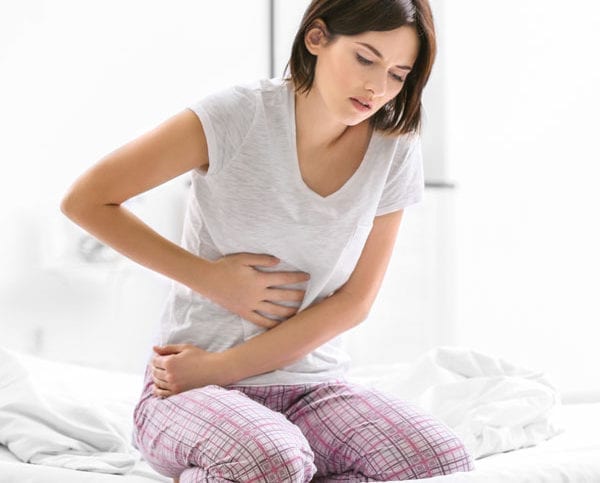By David Dunaief, M.D.

Gallstones are a very common gastrointestinal disease; they affect up to 20 million Americans between the ages of 20 and 74, with a more than two-times increased occurrence in women than in men, according to the NHANES III survey (1). There are two types of gallstones, 80 percent of which are cholesterol stones and 20 percent of which are pigment stones.
Common symptoms
Gallstones may be asymptomatic; however, when gallstones block either the cystic or common bile ducts, symptoms occur. Symptoms include dull or crampy abdominal pain that is exacerbated by meals and lasts one to five hours. Jaundice, which includes yellowing of skin and eyes, is another symptom. Others include nausea and vomiting, rapid heart rate, hypotension (low blood pressure) and fever (2).
Tests used for diagnosis
Blood tests include complete blood count, where there may be a rise in white blood cells; liver enzymes; and the pancreatic enzymes lipase and amylase. In general, diagnostic tests that have more accuracy are the endoscopic ultrasonography (EUS) and endoscopic retrograde cholangiopancreatography (ERCP). However, these are invasive tests. Less accurate but noninvasive tests include abdominal X-ray, ultrasound and CAT scan (CT). The tests used also depend on where the stone may be located. Hepatobiliary (HIDA) scans are accurate if the stone is located in the cystic duct. And magnetic resonance retrograde cholangiopancreatography (MRCP) is used if the stone is thought to be located in the common bile duct (2).
What are the risk factors?
There are a multitude of risk factors. Some of these are modifiable, some others are not. The modifiable ones include obesity, measured by body mass index (BMI); rapid weight loss; fat consumption; hormone replacement therapy (HRT); oral contraceptives; decreased physical activity; Crohn’s disease; and certain drugs. One nonmodifiable risk factor is age; the older we get, the higher the risk, with age 40 being the demarcation line (3). Other risk factors are gender, with females being more predisposed; pregnancy; and family history (4). Let’s look at the evidence.
Obesity risks
Obesity may play an important role. Obesity is not age discriminant; it can impact both adults and children. The reason obesity is implicated is potentially due to bile becoming supersaturated (5). Bile is a substance produced in the liver and stored in the gallbladder. Bile aids in the digestion or breakdown of fats in the small intestines. Crystals may form, creating cholesterol gallstones from the bile.
Body mass index
A body mass index of greater than 30 kg/m² is considered obese. In a meta-analysis of two prospective, forward-looking observational trials, Copenhagen General Population Study and the Copenhagen City Heart Study, those in the highest quintile of BMI were almost three times as likely to experience symptomatic gallstones compared to those who were in the lowest quintile (6). The highest quintile was those who had a mean BMI of 32.5 kg/m² and thus were obese, whereas those in the lowest quintile had a mean BMI of 20.9 kg/m². This is a comparison of ideal to obese BMI. Not surprisingly, since women in general have a higher risk of gallstones, they also have a higher risk when their BMI is in the obese range compared to men, a 3.36-fold increase and 1.51-fold increase, respectively.
Also, the research showed that for every 1 kg/m² increase in BMI, there was a 7 percent increase in the risk of gallstones. Those who had genetic variants that increased their likelihood of an elevated BMI had an even greater increase in gallstone risk —17 percent — per 1 kg/m². In the study population of approximately 77,000, more than 4,000 participants became symptomatic for gallstones.
Gallstones in children
Sadly, obese children are not immune to gallstones, even though they are young. In a prospective observational study based on Kaiser Permanente data from southern California, children who were overweight had a twofold increased risk of gallstones (7). But if that is not enough, girls who were extremely obese had a higher propensity for gallstones, similar to women in the previous study, with a greater-than-sevenfold increase compared to a still very substantial greater-than-threefold increase for obese boys. Hispanic children were affected the most. The age range in this study was between 10 and 19 years old. Obesity is a disease that is blind to age.
Physical activity
We know physical activity is very important to stave off many diseases, but in this case, the lack of physical activity can be detrimental. In the Physicians’ Health Study, a prospective observational trial, those in the lowest quintile of activity between the ages of 40 and 64 had a 72 percent increased risk of gallstone formation, and those 65 and older had a 33 percent increased risk (8). Also, men who were 65 and older and watched television more than six hours a week were at least three times as likely to have gallstones as those who watched fewer hours. There was a substantial increased risk for those under 65, as well, though to a slightly lesser degree.
Diabetes rears its ugly head
Just like with obesity, diabetes is almost always a culprit for complications. In a prospective observational study, those with diabetes were at a significant 2.55-times greater risk of developing gallstones than those without (9). Again, women had a higher propensity than men, but both had significant increases in the risk of gallstone formation, 3.85-times and 2.03-times, respectively. There were almost 700 participants in this study. The researchers believe that an alteration in glucose (sugar) metabolism may create this disease risk.
Hormone replacement therapy
If you needed another reason to be leery of hormone replacement therapy (HRT), then gallstones might be it. In a prospective observational trial, women who used HRT, compared to those who did not, had a 10 percent increased risk in cholecystectomy — removal of the gallbladder — to treat gallstones (10). Though this may not sound like a large increase, oral HRT increased the risk 16 percent, and oral estrogen-only therapy without progestogens increased the risk the most, 38 percent. Transdermal HRT did not have a significantly increased risk.
It is never too early or too late to treat obesity before it causes, in this case, gallstones. With a lack of exercise, obesity is exacerbated and, not surprisingly, so is symptomatic gallstone formation. Diabetes needs to be controlled to prevent complications. HRT, unless menopausal symptoms are unbearable, continues to show why it may not be a good choice. Next week, we will look at the complications of gallstones and how to prevent them.
References: (1) Gastroenterology. 1999;117:632. (2) emedicine.medscape.com. (3) J Hepatol. 1993;18 Suppl 1:S43. (4) uptodate.com. (5) Best Pract Res Clin Gastroenterol. 2014 Aug;28:623-635. (6) Hepatology. 2013 Dec;58:2133-2141. (7) J Pediatr Gastroenterol Nutr. 2012;55:328-333. (8) Ann Intern Med. 1998;128:417. (9) Hepatology. 1997;2:787. (10) CMAJ. 2013;16;185:549-550.
Dr. Dunaief is a speaker, author and local lifestyle medicine physician focusing on the integration of medicine, nutrition, fitness and stress management. For further information, visit www.medicalcompassmd.com or consult your personal physician.







